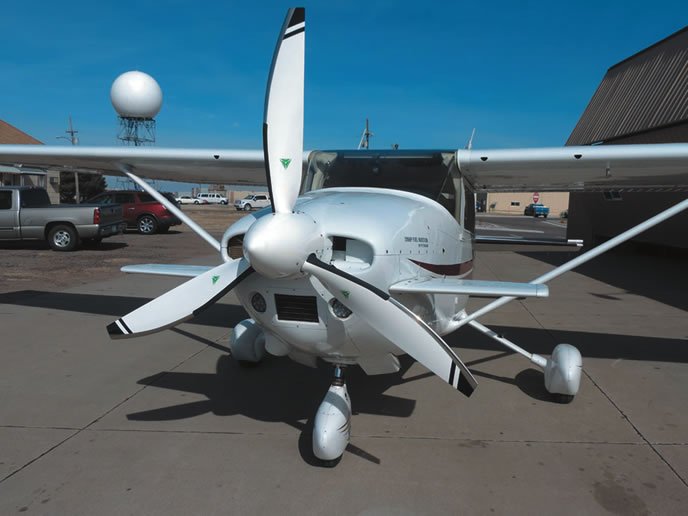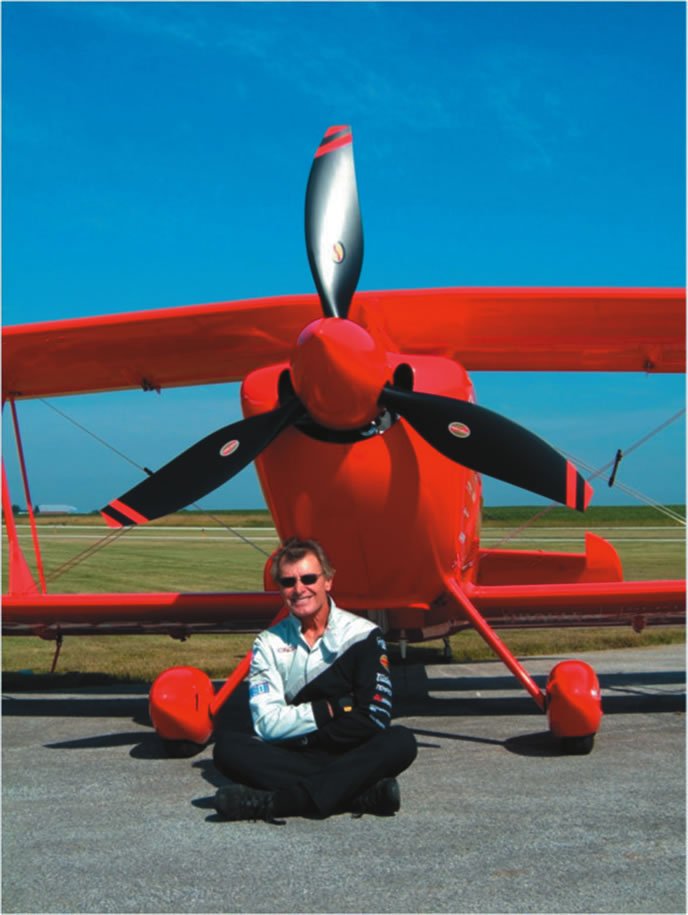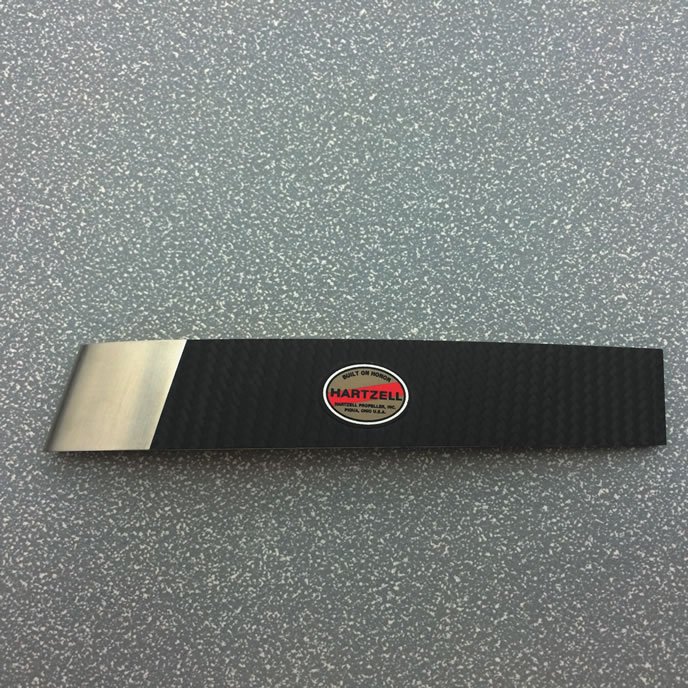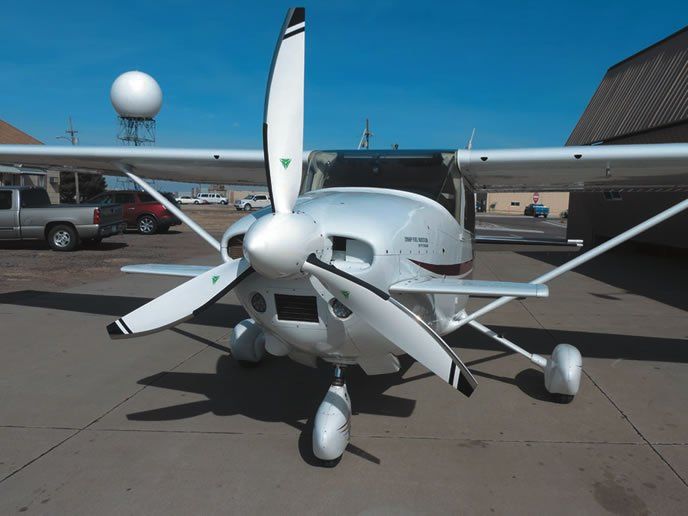With minimal fanfare, composite propellers have been appearing as original equipment on more and more airplanes and more and more owners are finding that they are an option for their airplanes when it comes time for an overhaul or replacement. Composite props are more expensive than their aluminum counterparts, so we were curious why owners are shelling out the extra bucks—what’s the attraction and what’s out there to buy?
First of all, what is a composite prop? At its most basic, it’s a prop that has blades at least partially made of layers of epoxy fiberglass, Kevlar or carbon fiber. The composite material is on top of a core that is either hollow (rare) or made of foam or wood. The base or ferrule of a constant speed prop is usually aluminum or steel and fits into a hub that may be identical to that of a prop with aluminum blades. A fixed pitch composite propeller may have no metal in it at all.

Weight
While the conservative certification requirements the FAA developed for composite airframes meant the anticipated major weight savings for composite airplanes never happened, composite materials have proven to greatly reduce the weight of propellers. According to MT-Propeller USA’s Peter Marshall, the weight saving ranges from five to 20 pounds over aluminum, depending on the prop. For the new prop from McCauley, the weight saving is even greater—35 pounds over the aluminum version.
The weight difference, especially as it occurs at one end of the center of gravity envelope, has a number of benefits, beyond simply increasing useful load—although that by itself is a big deal, especially in Light Sport applications.



Reduced weight of the prop means less gyroscopic and flywheel effect which, to a point, is beneficial for wear and tear on the engine, particularly the crankshaft and engine mounts. All things being equal, a lighter prop means longer engine life. It is especially valuable for airplanes flown regularly for aerobatics—and we’ve observed that many serious akro pilots have switched to composite props.
Composites allow more subtle and precise shaping of a propeller blade than can be accomplished with aluminum. There are limits to what can be done with an aluminum forging. The result is the ability to get more performance out of the prop, which results in more performance for the airplane. While we are always skeptical of speed increase claims, we have gotten reports of cruise speed improvements upon switching to a composite prop. The most remarkable we’ve heard is some eight knots for the Diamond DA-20 with an MT prop.
Hartzell took advantage of the weight savings and ability to fine-tune the shape of a propeller blade with its very wide chord Claw aerobatic props that provide significant additional thrust at low airspeed. The Claw is used by all of the Red Bull racers.
Repair
To prevent blade erosion, composite props have some sort of leading edge protection, usually made of steel or nickel. Nicks and dings to the composite material are repaired according to the manufacturer’s guidelines—as with aluminum blades, some damage can be field repaired, some has to be repaired in a prop shop and some is so bad the blade cannot be repaired. For field-repairable damage of a composite prop, the usual procedure is to apply an appropriate epoxy to bring the prop back to its original size and shape.
Because composite blades are never filed down in the process of repairing damage, as are metal blades, composite prop blade life is essentially infinite. Hartzell’s V.P. of sales and product support, Gary Chafin, told us that some turboprop airliners using Hartzell props have blades that have more than 50,000 hours in service.
TBO of a composite prop is comparable to metal props, however, the owner of a composite prop is never going to get the call from the prop shop telling her that the blades have been filed enough that they are undersized and have to be replaced.
Hartzell’s Chafin said that composite props are proving especially valuable in operations where the aircraft has a high utilization rate and repairs for nicks and dings can be handled at out stations when the aircraft is parked during the night, such as on commuter airlines and in bush operations.
Overhaul of a composite prop is similar to that of a constant-speed metal prop.
A side benefit of some MT composite propellers is that in the event of a prop strike, the blade may simply break off and not damage the engine (although a teardown is usually required).
Hartzell’s Chafin told us that a composite prop can be thought of as a tuning fork. By changing the diameter of the threads of the composite material, and the direction of the weave, the natural frequency of the propeller can be adjusted to the most desirable area for the engine-propeller combination. That has the effect of increasing the life of the engine. In addition, the wood or foam core of the blade absorbs some vibration.
More Blades
Another benefit of the weight saving of composite blades is that an additional blade or two can be added without exceeding the weight of the original, metal propeller. In addition to just plain looking cool, if designed correctly, more blades can provide multiple benefits: better performance, reduced vibration, reduced noise and greater ground clearance.



About 20 years ago, as the popularity of three-blade metal propellers to replace factory original two-blade propellers grew, we at Aviation Consumer surveyed owners regarding the phenomenon. We reported on it twice, more recently in the August 2005 issue. Our overall conclusion was that most owners bought three-blade propellers because more blades were more attractive than fewer. While many reported better initial acceleration and climb as we’ll as less vibration, most said that cruise speed was either the same or they had lost a few knots versus the two-blade prop on the airplane previously. By and large, however, performance didn’t matter—esthetics did.
Performance did matter to prop manufacturers and they found that a scimitar shape—sweeping the blades—fixed the cruise speed problem. With the ability to precisely shape the airfoil and allow some fairly radical blade sweep, we have not heard reports of cruise speed loss when owners switch to composite props with an additional blade. To the contrary, it appears that the more precisely molded, multiple-blade composite props are able to convert more of the engine’s power to thrust, improving all areas of performance while looking very good.
As the engine’s power pulses are spread over more blades, adding a blade reduces the momentary loads on the airframe, a benefit for airframe life.



Hartzell
Hartzell marketed its first composite propeller in 1978 for the CASA 212—it was constructed using a prepreg layup system. This was the first of what it now calls its legacy composite props, which are still in production. A metal shank is bonded into a foam core. The core is covered with a hand laid up prepreg material (originally Kevlar, now carbon fiber) and then the assembly is put into a press. Following the curing process, there are a number of operations, including bonding on a nickel erosion shield.
This creates what Gary Chafin referred to as a structural composite—a semi-monocoque, stressed shell structure.
In 2006, Hartzell developed its Advance Structural Composite (ASC) II propeller for the Cirrus SR22T. It uses a dry carbon fiber lay up, rather than prepreg. A sock is pulled over the foam core and a vacuum-assisted resin transfer process pulls the resin through the dry fibers in the mold. It also allows molding in the items that must be added post cure in the legacy props.
Once an ASC II propeller comes out of the mold, all that remains to be done is remove the flashing and add the finish coatings—cutting production time and cost substantially.


Chafin said that Hartzell originally developed its composite props for the airline industry because it could afford the development costs and badly needed propellers that could be repaired at out stations after suffering the kind of damage that routinely occurs in high-usage operations, such as being bumped by a baggage cart.


Composite technology combined with a nickel erosion shield—according to Chafin, it’s five times stronger than steel—meant that blade life is almost infinite.
The use of computational fluid dynamics (CFD) has allowed Hartzell to optimize prop shape, notably at the inboard end, to get more boost from its props and performance from the airplanes on which they are installed.
Hartzell composite props are available for a wide range of piston- and turbine-powered airplanes—check with Hartzell to see if one is available for your airplane. The information is not presented on its website, something that surprised us.
Contact Hartzell to get specific pricing for its composite props, however, we were told that for the Mooney Acclaim series prices run between $22,900 and $25,000, depending on ice protection. That compares with $12,700 to $13,300 for a three-blade aluminum scimitar prop. A three-blade composite prop for a Cirrus SR-22 is $33,235; a two-blade for a Husky is $23,075.
Chafin said that Hartzell has ramped up its certification of composite propellers, doubling the number each of the last few years. In the future it will be developing more props for Rotax engines as we’ll as geared diesels.
MT-propellers
MT-Propeller builds natural composite propellers. They are not structural composite propellers like Hartzell and McCauley, but highly compressed, layered, laminated beech and spruce wood reinforced with layers of epoxy fiberglass, Kevlar or carbon fiber and sealed with acrylic-polyurethane paint. An aluminum blade ferrule is attached to the wooden blade root with lag screws. The leading edge has erosion strips of either nickel or steel outboard and a self-adhesive PU strip inboard.
The composite covering of the wood allows precise shaping of the airfoil to maximize performance. Overall, MT props weigh from five to 20 pounds less than comparable aluminum props.
Originally building their lightweight props for aerobatic airplanes, MT almost immediately expanded into turboprops and then into piston airplanes—it now makes composite propellers for a substantial portion of the general aviation fleet, including those that use fixed-pitch props as we’ll as a number of vintage airplanes, such as the Boeing Stearman. As we were researching this article, it seemed as if the STC list on MT-Propeller’s website added an airplane every few weeks.
As with other composite props, MT blades have no life limit and are field repairable in accordance with the manufacturer’s guidance.
We noted that MT has aggressively gone the route of adding a blade to its props—where the aluminum factory original airplane had two blades, MT offers a three-blade; where the original was a three-blade, MT offers a four-blade replacement.
For pricing, it’s necessary to contact MT-Propeller USA. We did a check on a few airplanes: For a Diamond DA-20, $2850; Cessna 182, $12,500; Piper Cherokee Arrow, $12,000 and Beech Baron, $39,000 for a pair.
McCauley
Shortly after the Cessna Skycatcher came out, McCauley developed and received ASTM approval for a composite prop that weighed about half what the aluminum propeller did.
In April of this year, it received FAA certification under Part 35 for its first composite propeller targeted at Part 23 (and CAR 3) piston-engine airplanes of up to 350 horsepower. With three blades and weighing a whopping 35 pounds less than its aluminum competition (only 45 pounds installed), the McCauley Black Mac Carbon prop is the lightest of the composite propellers in its class.
McCauley Propeller Systems business leader Scott Howell told us that it is in the “tail end” of the process of receiving STCs for a number of high-performance, single-engine airplanes, including the Cirrus SR-22.
The propeller is a structural composite, with an engineered plastic shank (think roller skate wheel material) with a patented retention system that is a continuous carbon loop around a stainless steel ring. A high-density foam core is covered with carbon fiber making a semi-monocoque structure. There is a full-length nickel leading edge erosion strip that is field replaceable. It uses the standard, oil-filled, single-piece McCauley hub. Overhaul interval is 2400 hours or six years. The propeller is flanged for Continental engines, but Howell told us that they anticipate developing a version for Lycoming engines as well.
In April, the base price was announced as $18,000, although we suspect that number will change.
Over the next few months we expect to see McCauley identifying the airplanes on which the prop has been approved for installation.
Conclusion
We think the benefits of a composite propeller upgrade are convincing enough to justify the sizable price premium over traditional props—especially if you plan to keep the aircraft for a long time. These benefits include reduced weight and vibration, better noise reduction, longer service life and decent ramp appeal.


